The 9 Most Dangerous Animals In Our National Parks
This article originally appeared on Outside
We have cute bears in the Smokies. Deep black fur, chocolate-brown eyes, couple hundred pounds...giant teddy bears that look adorable from a safe distance.
Then one day I was running solo through Great Smoky Mountains National Park. I'd seen bears before, mostly from the saddle of my gravel bike, 100 yards away. But this time the bear was large, like a refrigerator on four paws, and just 30 feet off. I was alone, deep in the backcountry, and spooked it as I ran around a blind corner. The bear looked up, a sinister presence.
I couldn't remember what I was supposed to do. Should I look at my feet or stare back or run like hell?
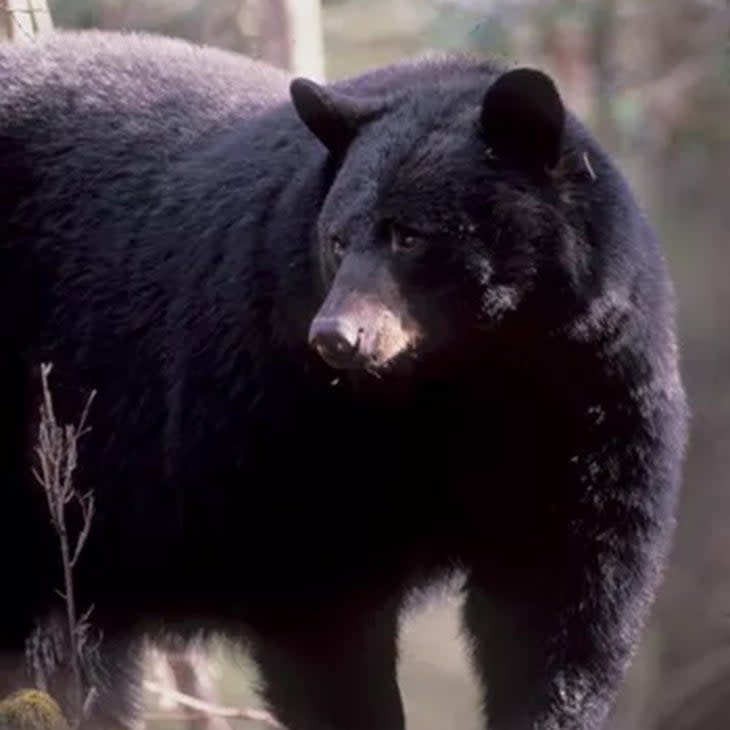
Fortunately, the bear was absorbed in scratching at the ground near a tree, and after a glance my way went about its business. I sidestepped off the trail, giving the massive beast a 200-foot berth while keeping my eyes on it. A hundred yards later I crept back on the trail, and we both went our separate ways. That's how most wildlife encounters go.
"People think they're monsters that are bloodthirsty [and] want to attack humans," says Jeremy Breitenstein, a wildlife photographer who's been taking pictures of bears in the lower 48 and Alaska for several years. "But it's just another wild animal that survives off vegetation. As long as you go into their territory prepared, you'll be OK."
Breitenstein did have a bad encounter with a grizzly in Alaska that tore into his tent. He didn't have food with him, but neither had he erected a portable electric fence, as is standard procedure in Alaska's backcountry, to protect himself. "It was my error," he says. "The bear was just curious. I talked to it calmly in a loud voice, and it backed away. Yes, accidents happen. Bears can be dangerous. But they're more scared of us than we should be of them."
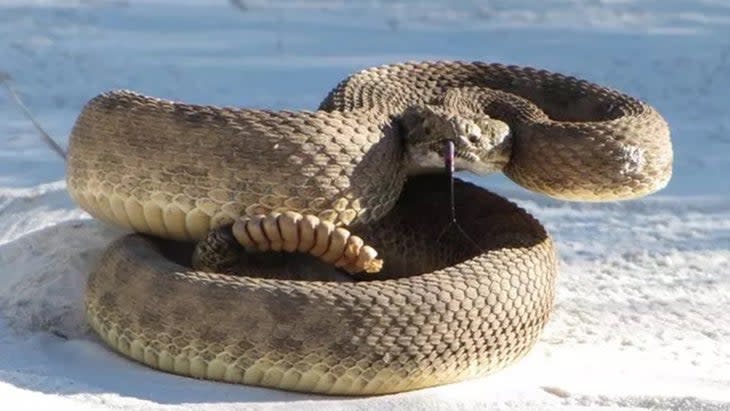
Bears are just one member of the animal kingdom you want to be prepared to see when you're spending time in our national parks, which protect the most dramatic landscapes--and the most abundant, diverse, and dangerous animals--in North America. This country's park system boasts giant reptiles in the south, big grizzlies up north, and stealthy cats in between.
These are nine of the most dangerous animals in our national parks and the best ways to stay safe while visiting their homes. These animals are amazing, and we need to respect them. When we work to keep ourselves safe, we're actually keeping the wildlife safe too, because when humans screw up, it's the animals that ultimately suffer.
Alligators and Crocodiles
Found: in Everglades National Park, coastal park units in Georgia and South Carolina, and throughout Gulf Coast states.
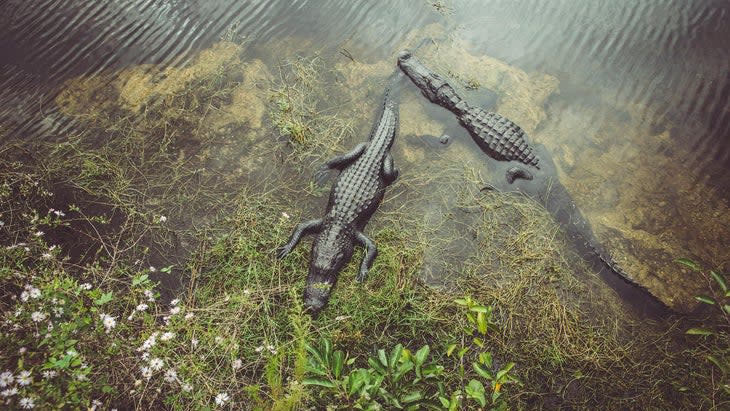
After appearing on the endangered-species list as recently as the 1980s, alligators have bounded back, and are now more than a million strong in Florida alone. The Florida Fish and Wildlife Conservation Commission notes that there have been 442 unprovoked attacks, including two dozen deaths, between 1948 and 2021. In the last decade, there have been an average of 10 alligator attacks a year, but according to the University of Florida, only 4 percent are fatal.
Still, their size is intimidating--adults can be 12 feet long and 500 pounds--and their jaws are loaded with 80 teeth, able to bite down with awesome force. And they look like dinosaurs. So yeah, terrifying.
But your chances of survival are good if you run into an alligator in Everglades National Park, where an estimated 200,000 are living and hunting in the rivers and wetlands. In fact, a couple of recent survival stories from the Everglades serve as cautionary yet encouraging tales.
In the fall of 2022, a man survived three days in the swamp after losing his arm to an alligator in Lake Manatee, north of the park. In 2020, a college student was bitten by an alligator near the Pahayokee Trail inside Everglades Park after swimming in a stagnant swamp with thick vegetation--prime gator habitat. She escaped with two puncture wounds and took herself to the hospital.

Staying safe in gator country is pretty straightforward, according to the Florida Fish and Wildlife Conservation Commission. Don't feed them and don’t swim in alligator habitat. The animals prefer slow-moving rivers and still swamps and ponds, preying on fish, frogs, and small animals. They typically feed at night, but are active during the day as well. If you're on land and a gator charges you, run as fast as you can. If you're bitten, fight back, aiming for the gator's eyes. If that fails, try to jam an object down its throat to induce a gag reflex.
In the Everglades, you also have the potential to run into an American crocodile, a saltwater-living species that can be found in the park's coastal waters. Crocodiles and alligators look similar (the croc snout is more pointed than a gator's) and behave similarly. There are far fewer crocs than gators--the park only has an estimated 2,000 of them)--but the Everglades is the only place in America where you'll find both species. Safety wise, the advice is the same: don't feed them, don't swim in their habitat, and if one charges you, run like hell.
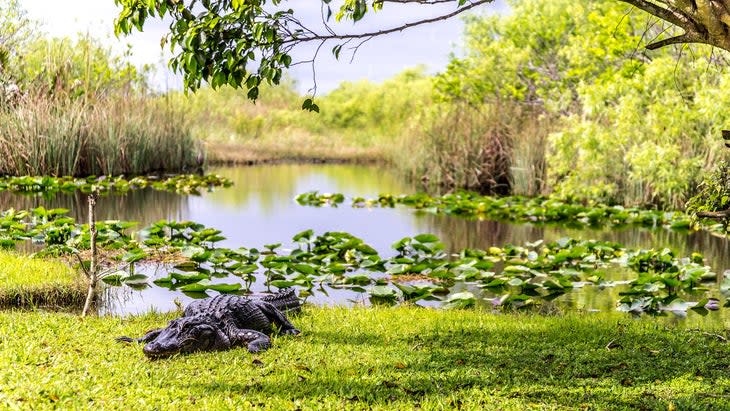
Mountain Lions
Found: in national parks from California to Texas, essentially all those in the American West, including Rocky Mountain National Park, Colorado; North Cascades National Park, Mount Rainier National Park, and Olympic National Park, Washington; Lassen Volcanic National Park, Sequoia National Park, and Yosemite National Park, California; Yellowstone National Park, in Wyoming, Montana and Idaho; and Everglades National Park, Florida.
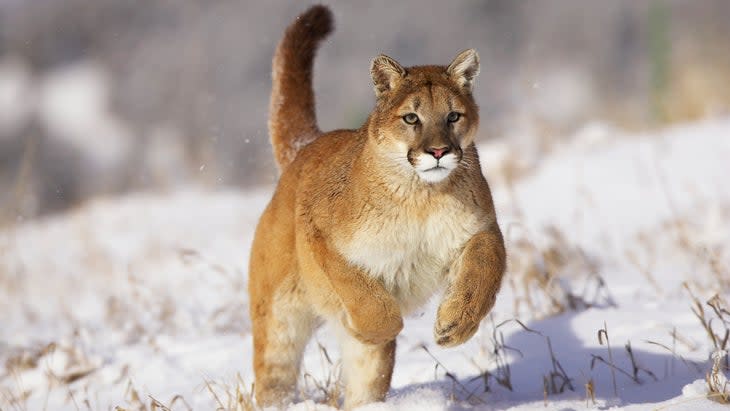
Panther, cougar, mountain lions...these are all different names for the same beautiful, big cat that mainly prowls the mountains and deserts of the Western U.S. There was a time when mountain lions roamed every state, but after overzealous hunting and habitat loss, they're relegated to 14 western states and a small population in Florida. Still they enjoy an almost mythical "boogeyman" status.
"I think big cats get to something deep down in our ape DNA, triggering an instinctual fear response," says Josh Rosenau, conservation associate with the Mountain Lion Foundation.
Tales of mountain lion encounters haunt our national park system, from the 10-year-old boy who was killed in Rocky Mountain National Park in 1997 to the trail runner who was attacked in the Santa Monica Mountains National Recreation Area in September 2022.
Still, there have only been 24 human fatalities from lions in the last 100 years, far fewer than the majority of other animals on this list.
"These cats are so elusive, and try so hard to avoid people, that a hiker would be lucky to even see a single mountain lion once in their entire life, let alone have a scary encounter," Rosenau says.
When attacks occur, he adds, it's usually because a hiker surprises a cat that's hiding close to a trail. The best avoidance is to hike in groups, and try to keep your dogs and children close to the group if possible. Most of all, talk to each other while you hike. "Human voices are an effective deterrent," Rosenau says. "One researcher even found that playing talk radio near livestock kept cats away." (Read a story about someone who found success with Metallica to deter a mountain lion.)
If you encounter a mountain lion in the wild, don't run. That just triggers their chase gene. Instead, stand tall, maintain eye contact, and let the animal know you're willing to defend yourself. Make yourself big, wave your hands, and make noise.
"On the rare occasion that a mountain lion attacks, you usually only have to scream at it," Rosenau says, "and it flees."
Great White and Tiger Sharks
Great Whites found: in Channel Islands National Park, Point Reyes National Park...basically any park in California that touches the Pacific, also Cape Cod National Seashore, and Acadia National Park
Tiger Sharks Found: in Biscayne National Park, Dry Tortugas National Park, and in the waters surrounding Hawaii's national parks.
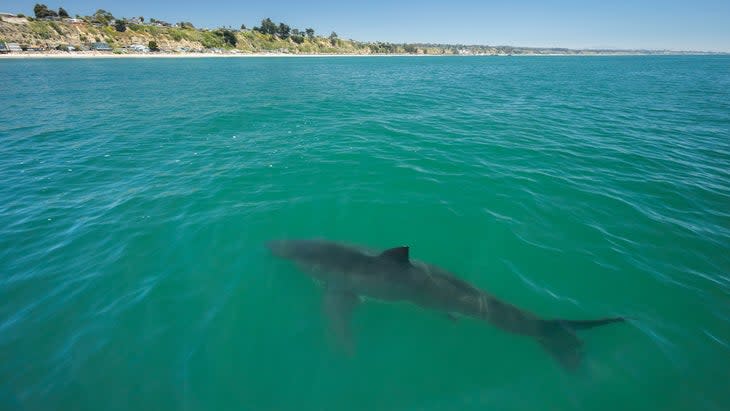
Last winter, a swimmer was snorkeling off the coast of Dry Tortugas National Park, a cluster of protected islands south of the Florida Keys, when a six-foot lemon shark attacked, biting her left foot. The shark tugged at her leg and she reacted immediately, kicking at its face with her good leg, then punching it in the face with her fists until she broke free and swam to shore. This is the way most shark attacks go, according to Gavin Naylor, director of the International Shark Attack Report, which gathers and studies incidents from all over the world.
"Most shark attacks are quick. A shark bites an ankle or arm, doesn't like what it's bitten, and moves on," Naylor says, adding that statistically speaking, you're most likely to be bitten by a requiem shark, a classification that include blacktip and lemon sharks--both of which are commonly found near beaches. But great-white and tiger-shark bites are more likely to be fatal, simply because of the size of the animals.
"Tiger sharks are huge, like 1,000 pounds, so a bite can remove a limb," Taylor says. "They also tend to stick around after a bite, circling."
As for white sharks, they're often twice as big. "They're so explosive, coming up from below," he says. "It's unlikely you could be stitched up after a white shark attack."
In terms of the ratio of fatality per attack, the white shark is the king, according to multiple sources.
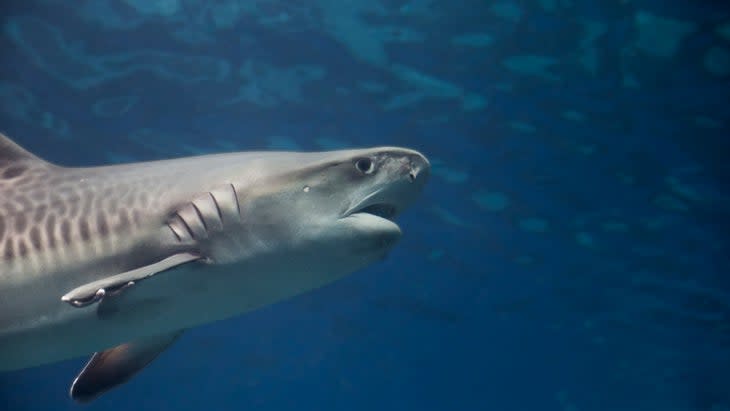
White sharks are fond of cold waters and can be found off the coast of California and New England, though they've been recorded in the warmer waters around Florida, too. Tiger sharks stick to warmer temps and are common around Hawaii and Florida. Safety measures are mostly common sense--don't swim alone, try not to swim at twilight hours, avoid water where people are actively fishing, and don't swim with an open wound.
Taylor insists that shark attacks be put in context. There were only 57 attacks confirmed worldwide last year; Florida had the most, with 16 attacks in 2022, mainly because of an abundance of opportunity.
"Florida has a lot of beaches, with a lot of tourists, and it's warm all year," Naylor says. "But sharks aren't dangerous at all, really. You're between 100 and 200 times more likely to drown than be bitten by a shark."
Grizzly Bears, aka Brown Bears
Found: throughout Alaska including in Katmai National Park, Kenai Fjords National Park, Glacier Bay National Park, Denali National Park, Kobuk Valley National Park, Wrangell-St. Elias, and Lake Clark National Park; in the lower 48, Glacier National Park and Yellowstone National Park have populations.
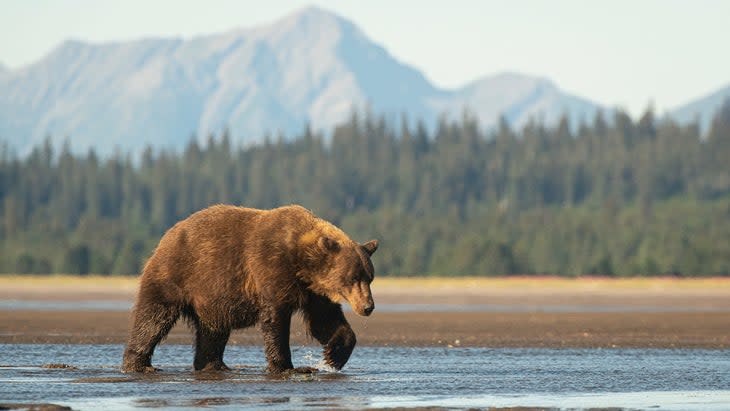
Alaska's Katmai National Park is ground zero for brown bears. The park was actually established in 1918 to protect the species and now boasts 2,000 of them, the largest population in the United States. Katmai is also home to the very popular Brooks Falls webcam, where you can watch grizzlies fishing for salmon from the comfort of your home.
Alaska is the only state that supports all three species of bear, and it sees the most bear attacks in the U.S. Probably the most famous happened in Katmai National Park, when Timothy Treadwell, a filmmaker who made a name for himself by interacting with the species in uncomfortable ways, and his girlfriend, Amie Huguenard, were attacked and killed while sleeping in a tent in 2003.
In the lower 48, Yellowstone has its own population, with an estimated 150 brown bears living inside its borders. According to Yellowstone's data, only 44 people have been injured inside the park out of 118 million visits since 1979. The park says venturing into the backcountry increases your risk of grizzly attack, with 1 in 232,613 backcountry hikers attacked as opposed to 1 in 59.5 million visitors in the front-country developed areas.
Since 1872, when the park was established, only eight people have been killed by grizzlies inside the park. Compare that to the park's 125 drowning victims, 23 deaths from falling into hot springs, or seven killed by falling trees. The last death inside the park was in August 2015 when a solo day hiker was killed by an adult female grizzly with two cubs near Elephant Back Loop Trail.
In July 2021, a 65-year-old cyclist, Leah Lokan, was killed by a grizzly while camping in the small town of Ovando, Montana, near Flathead National Forest. While Lokan was an experienced outdoors person and armed herself with bear spray and removed the most obvious sources of food smell from her tent, something can be learned from the accident (which did not occur in a national park). She was awakened early in the morning by a 400-pound grizzly sniffing around her tent. She yelled, "Bear!" to warn two other cyclists who were also camping, and the grizzly fled.
Lokan removed food from her tent and re-entered it. The bear returned an hour later, killing her. According to a 25-page report of the incident by the U.S. Fish and Wildlife Service, bags that once contained dried blueberries were found inside the tent and retained some aroma, and food had been left inside saddlebags on her bike, which was roughly 10 feet away. Wildlife officials determined the bear had developed a "predatory instinct" that was likely triggered by the food in the bike bags as well as the lingering smell of food cooked at a picnic during the day. The main mistake, according to wildlife officials, was returning to the tent after the first bear encounter.
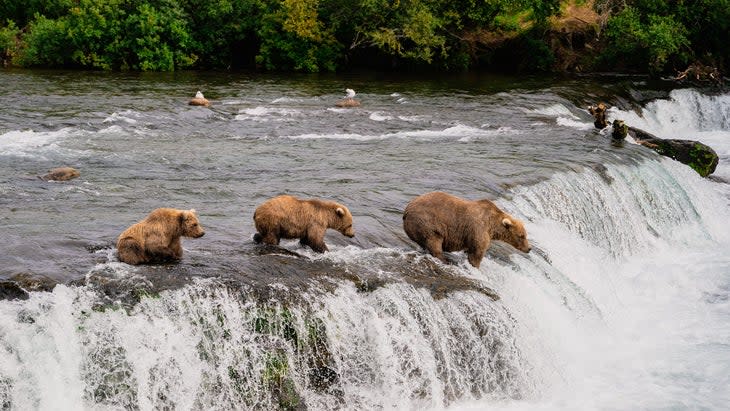
The National Park Service recommends a handful of clear practices to stay safe in bear country. One is never to hike alone. Instead, hike in groups of three or more, and talk during your hike. That alone gives you the best chance of avoiding a grizzly encounter in the wild. Carry bear spray, never leave your pack unattended (bears that find human food in packs can get habituated to it and become problem bears in the future), and stay on maintained trails.
Research in Yellowstone suggests people are more likely to encounter bears when off-trail. But the golden rule of traveling in bear country is to store food, and anything that smells like food, away from your tent. According to the U.S. Department of Agriculture, you should cook and store food at least 100 yards from your tent if possible.
"We want to prevent bears from associating humans as a food source, so food storage while hiking and camping is very important," says Leslie Skora, a wildlife biologist with Katmai National Park, in an email. "It's a good idea to store all scented items in a bear-resistant container while camping. Other precautions while camping are to keep a separate cooking area away from the sleeping area. Electric fences are another option to help deter bears from investigating camps."
Mojave Rattlesnakes
Found: in national parks in California; Death Valley, Nevada; Big Bend National Park, Texas; Grand Canyon and Saguaro national parks, Arizona; and Carlsbad Caverns National Park, and other New Mexico parks.
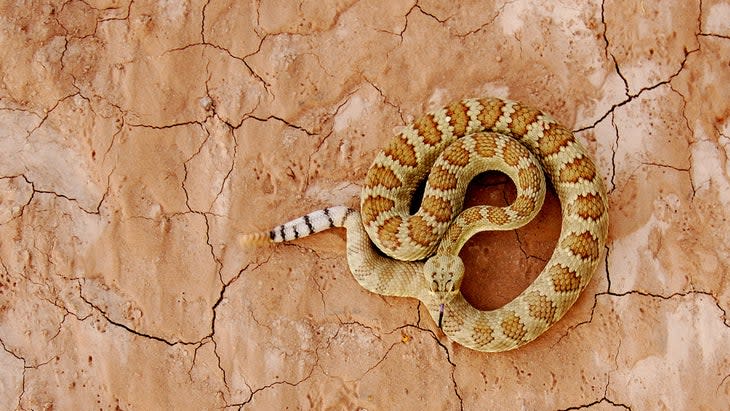
We have a lot of rattlesnakes in North America. There are more than 20 different species found in so many states across the country, it's easier to list those that have none: Alaska, Hawaii, Maine, and Rhode Island, though they are rare and endangered in a number of others.
While the Mojave rattler is found in the parks many western national parks parks, other rattlesnake species are found in parks including Shenandoah, Great Smoky Mountains, Everglades, Badlands, Theodore Roosevelt, Yellowstone (but not Glacier), Great Basin, Zion, and Rocky Mountain.
The variety of rattlesnakes in the U.S. is vast, from the Eastern Diamondback, which loves the long pine forests of the Southeast and can be found in parks throughout the region, from the Everglades to Cumberland Island National Seashore, to the sidewinder, found in the deserts of the Southwest. Rattlers look to be one of the few species poised to handle our changing climate. According to a recent study by Cal Poly San Luis Obispo and the University of Michigan, the seven species of rattlesnakes found in California are set to experience population growth thanks to climate change; the warmer climate will make it easier for the snakes to reach optimal internal temperatures for eating and reproducing, and to stay active through more of the year. Awesome.
Given the numbers of rattlers in the wild, encounters are inevitable (read about one here). According to the U.S. Fish and Wildlife Service, roughly 8,000 people are bitten by venomous snakes (including rattlers) annually, with 10 to 15 deaths per year.
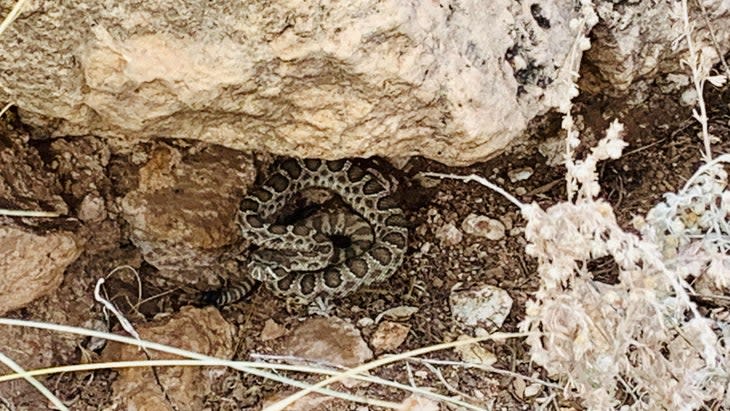
In 2020, two rattlesnake bites were recorded in Yosemite National Park within the span of three days, and both required helicopter evacuations. The most dramatic involved a backpacker who was bitten while fishing barefoot in the Grand Canyon of the Tuolumne River. The man and his wife tried hiking out together, but he was unable. She pinned his location on her phone and hiked through most of the night until she found another backpacker, who had a satellite device and called for a rescue. The bite victim was helicoptered to a nearby hospital, given two doses of antivenom, and discharged.
Fortunately for that backpacker, Yosemite is home to only one kind of rattlesnake, the Northern Pacific rattler, a relatively mild species, especially compared to the Mojave rattlesnake, which is considered the most deadly snake in North America, with venom as toxic as a cobra's. A bite from a Mojave rattlesnake can cause breathing problems, blurred vision, weakness, and even cardiac arrest.
"They're 10 times more venomous than any other rattlesnake," says Jason Wallace, program director for the Desert Studies Center, just outside of the Mojave National Preserve, San Bernardino County, California, which has a thriving population of Mojave rattlers. "It actually has two types of venom; one messes with your nervous system and respiratory system, and the other destroys tissue cells."
There are legends about aggressive Mojave rattlesnakes, with stories of people being chased by them, but Wallace calls that folklore. "They'll get aggressive if you corner them, but they don't want to mess with you. Usually, you won't even see them because they're nocturnal, and they hide when they feel the vibrations from your feet."
To avoid a rattlesnake, try to be aware of your surroundings. Wear thick hiking boots and long pants and watch where you put your hands and feet. Use trekking poles and always zip tents up. If you are bitten, stay calm and forget everything you've ever heard about snake bites. Do not apply a tourniquet, do not try to suck the venom out, and don't bother with a rattlesnake kit. "It's a fun souvenir, but worthless," Wallace says.
Instead, call for help from the site if you can. Getting a picture of the snake will help the doctors determine the course of action. Walk calmly toward your car if it's nearby. Wash the site with soap and water if possible and remove any jewelry, because your extremities are likely to swell. The key, according to Wallace, is not to panic. "Freaking out moves the venom through your system faster. Keep in mind that getting bit by a rattlesnake is not a death sentence. There's antivenom out there."
Polar Bears
Found: in Arctic National Wildlife Refuge, Alaska. Polar bears have also been known to roam into the Bering Land Bridge National Preserve and Cape Krusenstern National Monument.
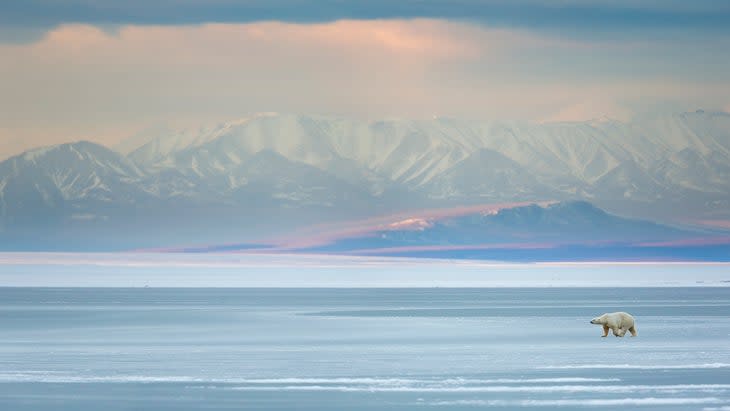
Polar bears thrive in the frigid, wet conditions that most humans avoid, living in the coldest coastal parts of Canada, Greenland, Norway, Russia, and the United States. They're great swimmers, clocking sustained speeds of 6 miles per hour in the water, and spend most of their time hanging out on ice sheets hunting for seals.
Polar-bear attacks on humans are rare: according to Polar Bears International, between 1870 and 2014 there were 73 confirmed polar-bear attacks on people. That's a low number, but attacks seem to be increasing in frequency, according to research performed by Polar Bears International. Scientists believe it might be the result of climate change and melting sea ice, forcing bears beyond their typical territory in search of food.
This past January saw the first reported human death by a polar bear in 30 years, when one charged through a small village on the tip of the Seward Peninsula in western Alaska and killed a woman and her child.
The polar bear is the top predator in the arctic, weighing in at 2,000 pounds, with 42 razor-sharp teeth and a top land speed of 25 miles per hour. Michael Wald, owner of Arctic Wild, a guide service leading trips through the Arctic National Wildlife Refuge, told us in an email that the best defense is avoidance. "We almost never see them on our guided camping trips and work to make sure we are not in areas where they are likely to be," he wrote. "In particular, we avoid camping on the Arctic Coast in August, when there tend to be lots of polar bears" hunting seals, in preparation for winter.
Still, Wald likes seeing polar bears in the wild as much as anyone. "They are beautiful animals and their power is evident. Even seeing polar-bear tracks is thrilling."
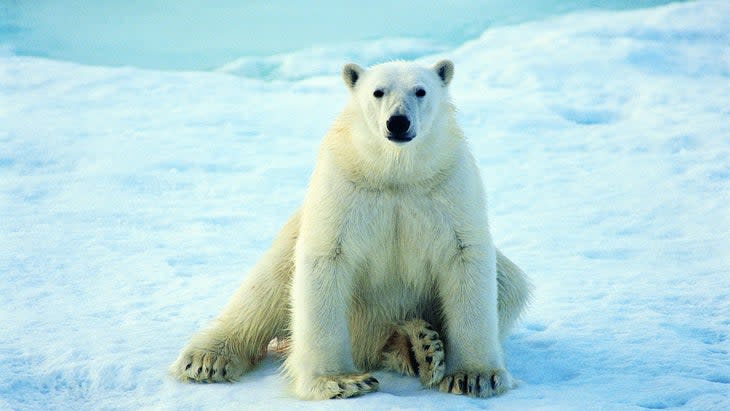
While avoidance is the best tactic, if you are traveling along the coast of the Arctic Wildlife Refuge, the Fish and Wildlife Service recommends developing a safety plan that includes 24-hour bear monitoring (continually scoping your intended terrain), and carrying bear-resistant storage containers, binoculars, pepper spray, noise makers, and electric fences. Camp at least a mile inland to reduce potential for contact. Travel in groups, have a designated bear spotter, and have specific plans for encountering bears at different distances. Sleeping in shifts is a good idea, too.
"If you understand and respect bears, you can avoid most problems with them," Wald says. "Don't invade their space and surprise them, and don't give them a reason to be curious about you or your camp. Peaceful coexistence is achievable."
If you encounter a bear, don't run. Pull your bear spray out, remove the safety clip, and be patient. If the animal is unaware of you, wait until it's safe to move. If the bear approaches you, defend yourself using your bear deterrent as soon as it's in range (within 25 feet). If that fails, fight back, aiming your fists at the bear's nose.
Box Jellyfish
Found: off the coast of Hawaii's National Parks and occasionally the U.S. Virgin Islands National Park.
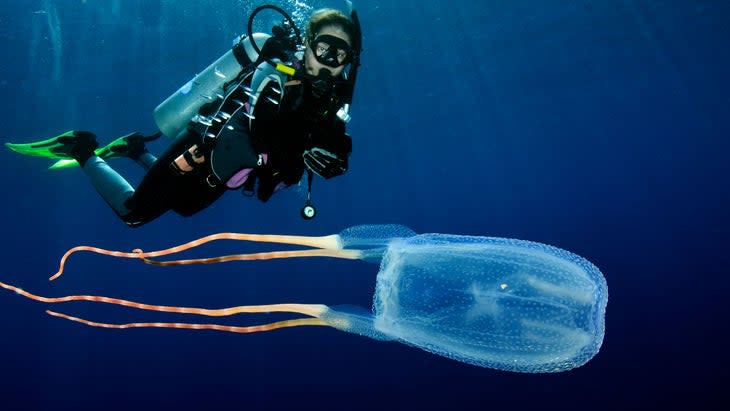
Getting stung by a jellyfish sucks. The burning sensation is immediate. Your friend offers to pee on your leg to make it better. This is a myth: urine may exacerbate the stinging.
But getting stung by a box jellyfish, as can happen in Hawaii's parks and the U.S. Virgin Islands, is far worse. This particular species is different from other jellyfish in that they have eyes and can actively swim instead of floating with the currents. They also have tentacles up to nine feet long, which are covered with tiny poisonous darts that can cause paralysis and cardiac arrest in victims. In fact, the box jellyfish is the most venomous marine animal on the planet.
Scientists can't agree on the exact mechanism that causes the cardiac arrest, but the venom targets the nervous system, red-blood cells, and ultimately the heart. Still, deaths from box jellyfish are rare--only 79 have been reported since the late 1800s, when scientists began keeping records. Children are at the highest risk.
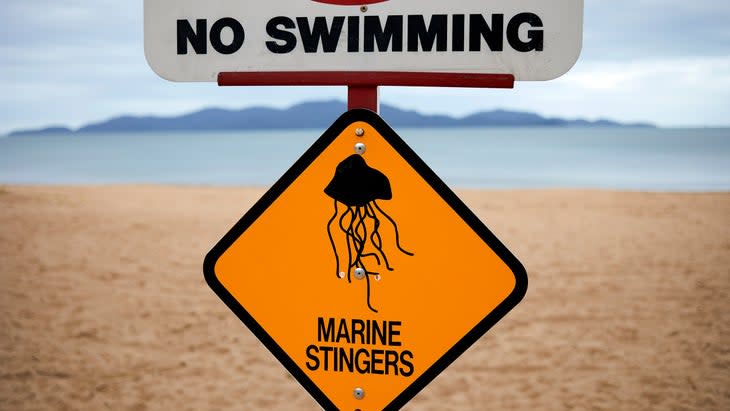
Fortunately, avoiding box jellyfish is pretty straightforward. They tend to appear close to Hawaii's coastline 10 days after a full moon each month, and safety officials issue regular public warnings. Stay out of the water during these times and you should be fine. If you do get stung by a box jelly and are having a severe reaction, go immediately to the emergency room. Treatment could include CPR and antivenom. Milder stings can be soaked in warm water to ease the pain.
Black Bears
Found: in Great Smoky Mountains National Park, North Carolina and Tennessee; Shenandoah National Park, Virginia; Yellowstone National Park, Wyoming, Montana, and Idaho; Grand Teton National Park, Wyoming; Glacier National Park, Montana; Mount Rainier National Park, Washington; Big Bend National Park, Texas; Denali National Park, Alaska; Rocky Mountain National Park, Colorado; Voyageurs National Park, Minnesota; Kings Canyon and Sequoia National Parks, Lassen Volcanic National Park, Redwood National Park, and Yosemite, California. There are a few in Acadia, Maine. Really, they are in just about every mountainous park with trees.
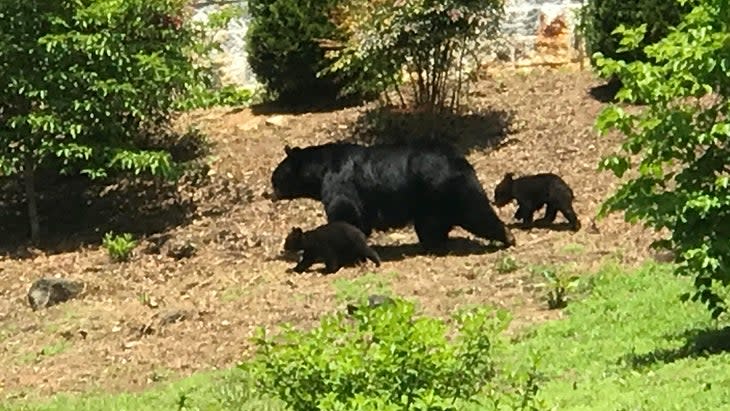
Grizzly bears might be the scariest species of bear in the lower 48, but you're more likely to encounter a black bear, because they are so prevalent. An estimated 750,000 black bears live in the forests of 32 states, stretching from Florida into Canada, and coast to coast. An estimated 1,900 bears live in Great Smoky Mountains National Park, which works out to two bears per square mile.
Black bears are no pushovers. They can grow up to six feet long, and weigh between 200 and 600 pounds. There were 48 fatal bear attacks in North America between 2000 and 2017, and black bears were responsible for 25. They eat whatever they can find, mostly berries and nuts, but will chow down on insects and small animals, too. They have a keen sense of smell, can climb trees, and are easily addicted to cocaine (just kidding).
Bear encounters are rare inside the parks, usually non-fatal, and occasionally comedic. In 2019, a bear was caught on camera sitting in a hot tub on a cabin's porch in Gatlinburg, Tennessee, on the Great Smoky Mountains park border.
But in a serious encounter last June, a family of five was camping in Elkmont Campground, when a bear tore into their tent at 5 A.M., attacking a three-year-old girl and her mother. The bear was large--around 350 pounds--which park biologists believe suggests it had regular access to non-natural food sources. Rangers think the bear was attracted to food smells in the campground, particularly dog food left out at the site.
The father was able to scare the bear from the tent, and the victims suffered superficial lacerations to their heads. Rangers closed the campground, set traps, and monitored the area. A male bear was captured and euthanized, which leads us back to what I said earlier on: most of the time human-wildlife encounters end up worse for the animal.
The number-one rule with black bears: don't feed them. A subset of that rule is to secure your food if you're camping in bear country. That means storing all your food and anything that smells like food in your car if you're in the frontcountry, and using a bear-proof container in the backcountry. Black bears have the best sense of smell of any land animal in the U.S., so that toothpaste container or half-eaten protein bar in your pack, tucked into the corner of your tent, smells delicious.
If you encounter a bear on the trail, keep your distance. Black bears mostly attack when feeling defensive. If the bear charges, stand your ground. Do not run, as bears love a chase and are faster than you. Make yourself big and loud. Throw rocks if the bear persists. When the bear is within 20 yards, discharge your bear spray. If that doesn't work, and the bear attacks, fight back. Aim for the nose, and punch like crazy.
Graham Averill is Outside's national park's columnist. He's typically too loud a hiker to encounter wildlife on the trail, but does see quite a few black bears while biking gravel roads in Pisgah National Forest near the Blue Ridge Parkway, North Carolina. His healthy fear of sharks would keep him out of the ocean if he didn't love surfing so much.
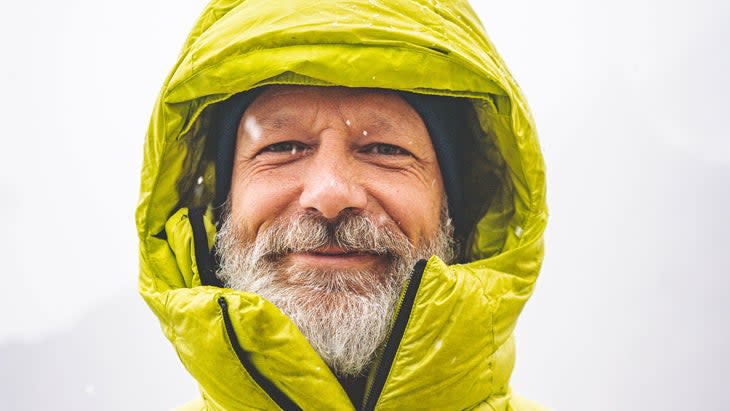
For exclusive access to all of our fitness, gear, adventure, and travel stories, plus discounts on trips, events, and gear, sign up for Outside+ today.

